Search Results
Your search for LearnMore returned 16 categories and 64 items
Items
About Us > Our Teachers > Meet Linda > Accolades

Linda Inducted into 2007 Massage Therapy Hall of Fame
Linda Tellington-Jones' work has its roots in a philosophy that sees all beings - humans and animals alike - as reflections of a Divine Whole. The Tellington Method was first created four decades ago as a system of animal training, healing and communication that allows people to relate to animals in a deeper, more compassionate way - a way that furthers inter-species connection and honors the body, mind and spirit of both animals and their people. The Tellington Method utilizes a variety of techniques of touch, movement and body language to affect behavior, performance, and health, and to increase an animal's willingness and ability to learn in a painless and anxiety-free environment.
Linda's highly effective and revolutionary approach to working with animals brought her world wide recognition, and it was out of this success that Tellington TTouch for humans has arisen, emerging as an important addition to the increasingly respected world of alternative healing practices.
About Us > Our Teachers > Meet Our Instructors
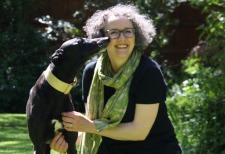
Rachel Ann Jackson
Rachel was born and raised in the North West of the UK. From a very young age she loved animals and especially wanted a dog, and at a very young age lived with three wonderful Pomeranians. She started horse riding at seven years old, horses are her second love and loves riding side saddle.
After qualifying as a primary school teacher and getting married, twenty-five years ago, her and her husband adopted a beautiful, sweet, two year old lurcher from a local rescue. It soon became clear that Fionn was petrified of other dogs, among other things. In her desire to help Fionn, Rachel started to learn about dog behaviour, completing a two-year dog trainer and behaviour course and then found Tellington TTouch® Training method. She describes this as her lightbulb moment, this was what she wanted to learn all about after she discovered how wonderful it was for Fionn. She booked straight away onto her first TTouch training in September 2000 and hasn’t looked back since.
Rachel went back to university in 2016 to study as a Veterinary Physiotherapist because she noticed that many dogs were struggling physically as well as behaviourally and qualified in 2018. Since then she has combined her work in both these modalities to enhance the physical and behavioural well-being of her own and client’s dogs. Rachel has a passion for the older dog, keeping them as fit, healthy and mobile as they can be. In addition to this, Rachel loves to teach guardians the importance of communication between them and their dogs and how to really listen to their canine friends.
Over the past twenty-four years Rachel has fostered many dogs, predominantly greyhounds and lurchers of varying sizes, shapes and ages. TTouch has benefitted each and every one of them. Sighthounds are her massive passion and there will always be a Jackson sighthound. Rachel volunteers at her local Dogs Trust and other rescues for many years. She uses TTouch techniques to help the more stressed and troubled dogs in their rescue be ready for their forever homes, with those already in homes, as well as many staff trainings.
Now Rachel gives private consultations and teaches workshops and trainings, in person and online nationally and internationally. She teaches the Tellington TTouch® Training Method and topics including pain and behaviour, proprioception and anatomy amongst others.
Rachel was made a Tellington TTouch® Method Instructor in 2021. She lives in South Manchester, UK with her husband, two greyhounds and a lurcher. You can learnmore about Rachel and contact her via www.wellbalancedanimals-vetphysio.co.uk wellbalancedanimals@gmail.com
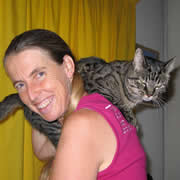
Lindy Dekker
Lindy started riding at age 10 in Stellenbosch near Cape Town, South Africa. The majority of the horses were rescued racehorses with problems. She was always surrounded by animals and her parental home was never without at least two dogs and two cats. She was given a rescued donkey in 1967 and had him for four years.
After studying Biochemistry, Microbiology and Genetics at university, Lindy moved with her husband Rick to Johannesburg in 1979. There she changed careers to become a computer programmer, and she is still involved in doing support for a consulting company.
In 1987 Lindy reached her dream and acquired her first horse 'Babyshoes' (ex-racehorse TB gelding) who stayed with her for nearly 21 years. Lindy has competed in dressage to Elementary level. In March, 1999 she attended a Natural Healing course for animals that included Reiki and Aromatherapy as well as an introduction to the Tellington TTouch® Method. She started her own therapy business in 2000. In January, 2001 she attended her first five-day TTouch® workshop for horses and hasn't looked back. She has been organizing the Tellington TTouch® practitioner training clinics in Johannesburg since 2002.
Now Lindy is a Tellington TTouch® Instructor for Companion Animals and for Horses. Besides organizing the practitioner training clinics for the Tellington TTouch® Method for horses, she gives clinics as well as private consultations for both horses and companion animals while traveling to all sorts of interesting places!
To learnmore about Lindy, visit her website, www.lindydekker.com.
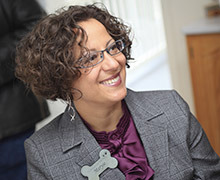
Maryse Perreault
As long as she can remember, Maryse, was always fascinated by the oneness of life and nature. As a child, following her father’s teachings, she would wander in silence in the forest, in a sort of meditative state, ‘’listening to the sound of life’’ as her father and grandfather would say. She became fascinated by interspecies bonds and relationships, including the human and companion animal bond.
What always piqued her interest was trying to understand the other and trying to establish a bond of trust without using words. As a result of this, she would unexpectedly find herself being touched by vivid emotions forming relationships that are sometimes so simple and sometimes very complex.
Later, two events brought TTouch on her path. Her dog was diagnosed with Addison’s disease, and she met with Lucie Leclerc, who was then a TTouch practitioner and assistant. These life events gave her the curiosity and interest to learnmore about TTouch and it ended up completely changing her life path and career goals.
She continued her TTouch training until she became a TTouch practitioner. Up until this point, she had received her degrees in Geology and Communication but was also working, in her spare time, as a dog trainer using positive reinforcement and as an animal-assisted activities practitioner and teacher.
From then on, she dedicated her life to teaching TTouch to numerous groups of people with different backgrounds within the animal field like groomers, shelter employees, dog trainers, and animal-assisted activities practitioners, for example. She was also an active mentor to both French and English-speaking students.
She wrote articles in French for blogs, also translating numerous documents and training, and teaching online classes as well.
In her desire to better understand the TTouch method and develop her self-awareness abilities, she went on to explore the world of somatic education. She amongst other methods, explored Tai Chi, Qi Gong, Karate, the Feldenkrais Method… She ended up earning a degree in the field and now also teaches voice guided somatic work inspired by Moshe Feldenkrais in Québec, Canada.
That work, along with the TTouch work, influenced and changed the way she teaches animal-assisted activities/therapy work. She has worked with dogs, rabbits and other small animals from shelters and helping them manage their stress, anxiety and nervousness has been a growing passion from the very beginning.
As a companion animal Tellington TTouch instructor, Maryse, sees again and again how animals, like humans, possess the resources that allow them to express their full potential and their relational skills.
She is proud to partake in the changes humans are putting forward in order to collaborate and to create authentic, supportive, and respectful alliances with their pets.
For more information about Maryse, visit her website www.essenceetalliances.com or contact her directly at ttouchquebec@gmail.com.
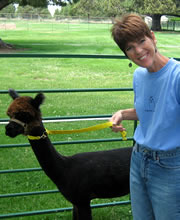
Marty McGee Bennett
Marty’s first llama jumped off the back of a pickup truck and into her heart in 1981. Since then Marty has devoted her professional life to the well being of llamas and alpacas and the education of camelid enthusiasts. After attending her first TTouch® demonstration in 1985 Marty attached herself to Linda for the next ten years learning the work with horses and adapting it for camelids.
In addition to her studies with Linda, Marty brings a variety of experience and qualifications to her work with camelids, including a B.S. degree in Animal Behavior and a professional background with fiber. This combination makes "Camelidynamics" the world’s most popular, and enduring training/handling system for camelids. Marty has taught the principles of camelid handling and the TTouch® to veterinarians and veterinary students at veterinary schools around the county and was the only non-DVM invited to contribute to the Veterinary Clinics of North America series on Camelids.
Her books (including one co-authored with Linda), videos and training clinics have helped thousands of llama and alpaca owners more fully understand, appreciate and enjoy this magical animal. Marty’s most recent book "The Camelid Companion" published in 2001 has received rave reviews in publications worldwide.
Conducting hundreds of clinics in North America and around the world including numerous trips to Australia, New Zealand and Europe have kept Marty on the road for much of the past 30 years. Marty her husband Brad live in New Smyrna Beach Florida and Marty still travels the world sharing her expertise on handling llamas and alpacas without fear or force. For more information about Marty, clinics, and products for camelids including a halter that is safe comfortable and effective for refined leading, log-in to Marty's websie
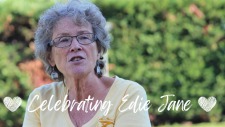
Edie Jane Eaton
The world lost a bright light in September of 2022. We are still in shock that our wonderful colleague, teacher and friend Edie Jane Eaton passed away suddenly after a short illness. We are dedicating the 2022 “Cell-ebration” in her honor and memory. We wish she could have joined us in person.
Edie Jane came to TTouch in the 1980’s on the suggestion of her Feldenkrais teacher. After one demo she was hooked and would become one of our beloved instructors.
Edie Jane was a phenomenal teacher and had a knack for balancing rational, concrete thought and her intuition and spirit. She was driven by curiosity for knowledge and possessed a calm, kindness that put everyone she met at ease. Well-spoken and full of wry observations, Edie Jane loved the natural world, a geologist by training, and had a thirst for adventure, she could count rally car racing as a hobby!
As a friend, she was fun, full of life and always interested in learning more. She had an eye for detail like no other. Edie Jane took many groups to Botswana on safari, horseback and otherwise, and loved the magic of the African bush. Her latest trip had been in May of this year and by all accounts it was spectacular.
We will miss Edie Jane more than words can describe. She changed the lives of so many people and animals over the decades she shared the Tellington TTouch around the world and she was an integral part of the development of the work. Her pivotal analogy of “Shedding Some Candlelight on Resistance” will continue to be shared in her memory.
Her family shared her obituary here.
We have been comforted with the wonderful stories and thoughts shared in our community as we have remembered Edie Jane. We will never forget her and we hope that she knew how life changing she was for so many.
About Us > Research & Studies
Horse 2001 Trailer Loading Study
Loading stress in the horse:
Behavioural and physiological measurement of the effectiveness of non-aversive training (TTEAM) for horses with trailer loading resistance.
This study was conducted by Stephanie Shanahan when she was a student at the University of Ontario Veterinary School at Guelph, Ontario, Canada. The research was funded by a grant from the Geraldine R. Dodge Foundation for Research targeting the Improvement of Animal Welfare. Stephanie won the American Veterinary Society of Animal Behavior's 'Award for Student Excellence in Applied Animal Behavior Research'. Permission to post from Journal of Applied Animal Welfare Science.
Abstract
Resistance to trailer loading in the horse is a common source of stress and injury to horses and their handlers. The objective of this study was to determine whether non-aversive training based on Tellington-TTouch Equine Awareness Method (TTEAM) would decrease loading time and reduce stress during loading for horses with a history of reluctance to load.
Ten horses described by their owners as "problem loaders" were subjected to pre-training and post-training assessments of loading. Each assessment involved two seven-minute loading sessions during which heart rate and saliva cortisol were measured. The training consisted of six 30-minute sessions over a two-week period during which the horse and owner participated in basic leading exercises with obstacles simulating aspects of trailering. Heart rate and saliva cortisol were shown to increase significantly during loading as compared to baseline (P<0.001 and P<0.05, respectively). Reassessment after training showed a decrease in loading time (P=0.01) and reduced heart rate during loading (P=0.001). Seven good loaders were also subject to loading assessment for physiological comparison. Increases in heart rate during loading were significantly higher in the good loaders (P<0.001). Non-aversive training simulating aspects of loading may effectively reduce loading time and stress during loading for horses with a history of resistance to loading.
As most of you know, in the summer of 1999, I conducted research retraining horses with trailer loading problems using TTEAM. So I'd like to give a general outline of what I did and what I was trying to do. In a later issue, I will present some of the interesting case studies that came out of the research.
Horses who are reluctant to load into a trailer are not difficult to find. In fact, it is one of the most common behaviour problems horse people are familiar with regardless of the breed of horse or discipline they are involved in. Unfortunately, trailer-loading accidents are also a common cause of injury to horses and their handlers.
My intention in this project was to scientifically ascertain the effectiveness of a TTEAM training program at improving willingness to load. I also wanted to know if the stress of loading would be measurable physiologically and furthermore, if TTEAM training could measurably decrease loading stress.
We started with 12 horses who, according to their owners, were difficult to load. The horses included a Shire/Thoroughbred yearling, two and four year old Quarter Horses, Arabian crosses, Canadian broodmares and a few thoroughbreds. The oldest horse in the study was 20 years old.
In the initial assessment, the horse had two seven-minute opportunities to load, one with the owner and one with an independent handler who did not know the horse or the purpose of the study. We measured heart rate and took saliva samples to measure cortisol before, during and after the loading. We performed this assessment with all the problem horses as well as with 8 horses who were considered to be good loaders.
In almost every case loading time was not significantly different when the owner or the person unfamiliar with the horse was loading.
One of the "problem loaders" loaded readily and one of the good loaders did not load so we didn't use them in the study but we did work with both of them anyway.
After the assessment some horses started the training while others waited and had a second assessment before the training. This was done in order to keep the independent handler blind to the training status of the horse.
The training program was based on a wonderful article by Marion Shearer, "Prepare your horse to load", which was recently reprinted in the May-June 2000 TTEAM Connections. The sessions were every other day for two weeks. It is definitely beneficial for horses (and people) to have a break between sessions in order for the brain to integrate the new information. Every other day is better than every day. Some horses may benefit from more than two weeks of training while others might only need to be asked differently at the time of loading.
Here are some of the most important components of the program we used (for more information, I strongly recommend reading Marion's article):
Lower the Horse's Head
Many of the problem loaders had naturally high head carriage. When they were concerned their head would go even higher making it difficult to negotiate getting into a trailer. This is a normal reaction for horses, a part of the flight response. They are raising their head to shift their weight back which lightens their front end so they can turn around quickly and get away from what is scaring them. The problem arises when the handler has no way of asking the horse to lower its head. It appears that lowering the head actually changes the horse's reaction to a situation. When the head is lowered, a horse is able to move forward to approach and investigate what it is concerned about. This gives the horse the opportunity to realize that the situation is okay. With his nose in the air, a horse is neither going forward nor giving the situation a chance, he is asking to leave.
As part of our training we used as many different ways as we could think of to teach the horses to lower their head when asked. Some of the ways are listed here:
Leading position:
- Putting the chain up the side of the halter
While standing:
- A gentle signal and release downward on the chain, or "milking" of the chain
- Stroking of the horse's chest and forearms with the wand
While walking:
- Allowing the horse to walk into the wand which is held in front of the horse midway between the knee and shoulder
Body work:
- Raising the back with the tips of the fingers pressing on the midline of the abdomen
- Tail work
- Mouth work and ear work
These may not lower the head directly but can be very useful to get the horse to pay attention and think about what you are asking when you are stuck
Since we only had a short period of time to work with and the owners were not familiar with TTEAM, we did not teach ALL the possible tools that COULD be useful when working with horses to improve their willingness to load. We focused on a few basic principles and were very happy with the results we got.
The training sessions involved the introduction of these TTEAM techniques at the pace that seemed appropriate for that particular horse and owner:
Leading positions
Cheetah: This was used as the BASIC leading position. The important principles were to habituate the owner to being further away and further ahead of their horse while leading. We emphasized that the horse would better be able to listen if they could see the person leading them. It was also an opportunity for the handler to learn to use the wand to more clearly communicate what they wanted the horse to do.
Dingo: This is considered a very important part of trailer loading problem solving. The horse must learn to go forward from a signal. It seems that horses understand the signal on the croup combined with the signal on the chain very well, but it is important for the handler to learn to coordinate this movement in a consistent manner.
Dance: It is believed that many horses are more concerned about backing OUT of the trailer than getting into the trailer. Imagine backing out of something and not being able to see or feel the ground behind you! Teaching a horse to back one step at a time and to negotiate backing over obstacles, inclines and off bridges makes the horse more willing to load onto the trailer as well as backing out more calmly and safely.
The obstacles we used were whatever combination of poles, planks, tarps and barrels was available. We tried to simulate the different aspects of what CAN be difficult for a horse when trailer loading:
1. Stepping over or onto something i.e. poles raised or piled, bridge, cavalettis
2. Stepping onto an unfamiliar surface that makes noise i.e. plastic tarp, plywood sheet, bridge
3. Walking into a narrow space i.e. poles raised on barrels, tarps hanging over the poles, plywood
4. Walking under a low roof i.e. an arch of wands, a Styrofoam pole, a rolled tarp
The horse would walk up to the obstacle and be asked to halt. If the horse's neck was above the horizontal, the handler would ask the horse to lower its head and then proceed with the obstacle. It is not necessary to stop EVERY time before negotiating an obstacle. It is useful, however, in order to make every step clear and intentional to practice stopping and moving forward in a controlled manner with the head lowered.
Some of the horses appeared not to know that their limbs were connected to their body. So we used the body wrap to help them get a sense of how they might coordinate legs and body as a unit. For the horses who could not step over a pole without tripping, the body wrap seemed to make a world of difference!
Body work
We also included one session of bodywork for each horse. We were focusing on touches that would help ground, calm and connect the horse. We started with an exploration of the horse's body, which the owners found FASCINATING. The reactions of the horse fit with the pattern of difficulties that they had with them on the ground and under saddle. All of a sudden they seemed to understand that the horse was not stubborn or difficult but tight or sore or habituated to a particular way of carrying itself.
The touches we used:
Grounding:
- Python lifts
- Leg exercises
Calming:
- Ear work
- Mouth work
Connecting:
- Raising the back
- Tail work
- Lick of the cow's tongue
- Noah's march
- Zigzags
Results
Seven of the ten horses who completed the study loaded in the allotted seven minutes on the final assessment, a very significant improvement from the initial assessment. Three of these seven loaded instantly, in less than 30 seconds, and did so repeatedly during the 14-minute loading assessment.
Of the three horses who did not load:
- one had fallen when the lead shank broke during the initial assessment
- another owner had chosen not to participate in the training sessions
- the third owner had been absent for the initial loading assessment and was so nervous at the final assessment that she was crying.
By analyzing the data we had collected, we were able to show that the heart rate and saliva cortisol increased significantly when a horse was asked to load. While after TTEAM training the willingness to load was significantly improved AND heart rate was significantly lower when they were asked to load. The saliva cortisol measurement was not sensitive enough with the small number of horses we had to show a difference after training.
Good loaders
One of the most interesting things we found was that the good loaders had a higher increase in heart rate when they were loaded onto a trailer than the problem loaders. We don't have a specific explanation for this. My guess is that even though these horses are obedient enough to load when asked, loading onto a trailer is still stressful, definitely more stressful than standing in the crossties! Conversely, the horse might associate the trailer with going somewhere exciting, like a competition or trail ride, and their excitement is reflected by the increase in heart rate.
We also noticed that the horses who moved around and whinnied the most while they were in the trailer had LOWER heart rates than the horses who just walked on and stood there. That was a real eye opener! How often we forget that freezing is a panic response!
- "He was just standing there, quiet as could be, and all of a sudden, he just exploded!".
- "He's not scared, he's just stubborn. He just stands there and doesn't move."
Just because an animal isn't showing overt signs of being stressed, it doesn't mean he is relaxed.
Discussion and further questions
When I told my childhood coach about my research project, her response was: "I think you should measure the stress of the handler instead of the horse". And I think there's some truth to that. I think a key component of the training program was the owner involvement. Learning to communicate more clearly what we want from our horses allows them to feel safer doing things that seem inherently unsafe, like getting into a trailer.
Will horses who have had a bad experience with a trailer benefit from this training?
In this training, we did not use a trailer at any time other than the assessments. There were specific orders that the horses should not spend any time near a trailer during the study. We did this in order to show that the fear of the trailer itself is often not the problem. When a horse is more confident about its coordination and balance and receiving clear communication from its handler, the trailer is suddenly no longer a problem. In some cases however, being in the trailer is much worse for the horse than loading onto the trailer. Some horses will load readily and as soon as they are in the trailer, their heart rate triples and they are sweating profusely. The response to specific exercises will vary from horse to horse because in each case, we don't know EXACTLY what the horse is concerned about. And there will be some situations in which this training will not be the answer.
What would happen if the good loaders went through the training program, would their heart rates be reduced?
Well, we don't know. It's possible. It is possible that doing TTEAM groundwork with these horses because of its many benefits unrelated to trailering may improve the horse's comfort with trailer loading by improving its balance and coordination.
What about using the Clicker? Why didn't you use a Clicker?
I didn't use a Clicker in this project because I wasn't very familiar with them at the time. Also, the more variables you introduce in research, the less meaningful it becomes. I have since spoken with MANY people (behaviourists, trainers, TTEAM Instructors) who would include Clicker and Target Training in a trailer loading program. I think it's a great idea. Definitely horses learn very quickly and enjoy learning with positive reinforcement!
Why didn't the saliva cortisol show a decrease after training?
We're still just in the beginning stages of applying the use of saliva cortisol to measure stress in horses. The number of horses and the interval of testing we used was not sensitive enough to be able to say whether or not there was a decrease. Though the increase during loading was significant, a lesser increase after training could not be demonstrated.
How significant was the bodywork in the training program?
Well there's no way of knowing this either since we did not have a group who received ground work without bodywork. But the owners definitely seemed to find it very important. If nothing else, it allowed them to look at their horse in a different way which is an essential part of learning to work with them differently.
Happy trailering, Steph Shanahan
NOTE: TTEAM is an acronym of "Tellington TTouch® Equine Awareness Method." Since this article was written, the brand name for all the facets of the TTouch® organization is Tellington TTouch®.
Events
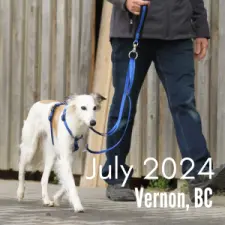
Hands On - Tellington TTouch® for Dogs
Want a calm, confident canine companion?
Looking for the skills to have more enjoyable, relaxing walks on leash?
Maybe you just want to add to your existing skills?
Enjoy the positive, fun filled learning environment that looks at dog training in an all encompassing, whole, way. This workshop can serve as an introduction to the Tellington TTouch Method for Dogs (and other Companion Animals) and build and refine the skills of more experienced students.
Professionals dog trainers and dedicated dog guardians alike will benefit from the variety of practical techniques and unique approaches learned in this class! Add layers of knowledge and skill to what you already to well and discover new ways of understanding and handling that you can integrate into your current program to achieve remarkable results.
During the session you will learn, develop and build on the fundamentals of Tellington TTouch Bodywork, Leash work, and Observation skills.
These skills will empower you with a variety of innovative techniques and exercises to help address the most common issues confronting dog owners, trainers, and other professionals; in a forward thinking, low-stress, positive manner.
This is an ideal method to help enhance positive dog training modalities. Bring your own dog or work with one at the course. There may be an opportunity to work with other species, such as horses, in a safe, confidence building way.
Can count to credit for Tellington TTouch Practitioner credits (8 or 12 credits), suitable for new and returning students.
Tuition
3-Day: $775 plus 5% GST
EARLY BIRD (Ends December 31, 2023) $650 plus 5% GST
5-Day: $1175 plus 5% GST
EARLY BIRD (Ends December 31, 2023) $950 plus 5% GST
Included in this course is our Online Course – “Tellington TTouch for Dogs – An Introduction”. $49.94 USD VALUE
Snacks, lunch and refreshments are included in the price.
Learnmore about the Facility and Accommodations.
For cancellations made more than 30 days in advance of the training, a refund will be given minus a $100 administration fee. No refunds are possible for cancellations less than 30 days prior to the start of the training, unless we can fill your spot. In some cases credit can go towards subsequent events.
We recommend that you purchase flight and hotel insurance for each event for which you register.
All prices are quoted in Canadian Dollars.
ttouch.ca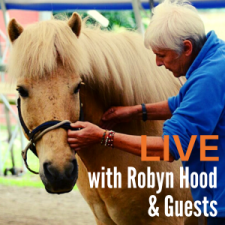
Interactive & Online Tellington TTouch® for Horses

Join Tellington TTouch Method Instructor, Robyn Hood, as well as other guest instructors, and develop a deep level of understanding and skill that will transform how you understand, handle and train horses.
Enjoy the logical, linear, learning of online learning along with the inspiring and adaptive format that includes 36 hours of small, LIVE, Zoom sessions – all recorded for your convenience and on-going learning.
This course is the ideal option for anyone seeking an integrative and compassionate approach to horse training and management. Whether you are a professional horse trainer or dedicated horse lover, this course will provide you with an incredible framework of philosophical understanding, observational skills, bodywork techniques, groundwork exercises, innovative tools, and work under saddle that can make what you already do well, be even better; all while developing a deeper, more trusting relationship.
The Tellington TTouch for Horses: Immersion Series can serve as your core curriculum for Tellington TTouch Online Academy Certification credits however it is also a fantastic learning opportunity for those wanting to add to what they already do well or expand their knowledge and skill set.
Register and gain access to an extensive, clearly laid out and detailed online course covering the material you would learn in at least two, 5 day hands on sessions. This course can be done at YOUR OWN PACE, before or after the LIVE sessions.
Beginning in March enjoy, the first of twelve, 3 hour immersion session that will leave you inspired, empowered and excited to learn and practice.
Between sessions you will work on specific skills and assignments, if you are working towards Certification. Sessions are recorded for future viewing or should you have to miss a live class. Each session will be taught by Robyn or another one of our wonderful TTouch Instructors.
Enjoy the comforts of home, with your animal at ease, in this small, intimate group setting. Robyn will help coach you through specific concerns you may have and give you the tools to enhance your horse’s well being, behavior and performance.
This course can count towards the Tellington TTouch Practitioner certification program for horses. It is also suitable for riders and horse enthusiasts who are interested in the method to enhance their relationship and address a myriad of challenges without force or dominance. All levels of experience and areas of interest are welcome.
Students will have access to online material to cover at their own pace. The online portion of learning consists of a logical, linear, “Tellington TTouch for Horsess – Core Curriuculum”, which can be accessed at any time.
The online portion of the course includes:
- The FULL Tellington TTouch for Horses Core Curriculum Course: Each consisting of several specific topics and lessons.
- Hours “how-to” videos and lectures about each specific concept and exercise
- Lesson video assignments, to be completed by those pursuing certification
- 24/7 access to all materials
The LIVE interactive portion of the course includes:
- TWELVE 3 hour sessions of learning in an intimate, supportive, group setting over the span of 6 months
- Class recordings for future viewing & review
- Access to an interactive group chat and discussion page.
- Expert feedback about your own animals
- In class assistants co-teaching and supporting the group’s learning and questions.
Payment plan available, please email ttouch@shaw.ca for information.
ttouch.ca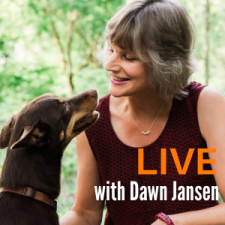
Interactive & Online Tellington TTouch for Dogs

Are you a dog lover?
DO you want to help your dog become a calm companion?
Have you recently added a rescue or shelter animal to your family?
Do you have a dog who needs a little extra support or has some specific challenges?
Maybe you simply want some positive, mindful ways to be with your animal.
Join Dawn Jansen (Tellington TTouch Instructor), weekly, starting March 2nd and learn trust-based, gentle, effective and supportive techniques from the comfort of home. This includes 10 hours of live, virtual, group instruction and 24/7 access to a self-paced online study course.
Discover techniques designed to cooperatively:
✅ Help your dog be their BEST selves!
✅ Enhance self-control
✅ Develop good leash habits
✅ Reduce anxiety & fear
✅ Address reactivity
✅ Support senior & special need dogs
✅Develop trust & Communication
TTouch offers simple, gentle, and effective ways to help your dog become more comfortable, self-controlled, and cooperative.
You will learn how to:
➔ Interpret your dog’s behavior in a non-judgmental way
➔ Notice a dog’s subtle body language for signs of stress or relaxation
➔ Use simple, relaxing body work techniques to support your dog and your relationship
➔ Support your dog to reduce anxiety and enhance self-confidence
➔ Incorporate leash exercises to create more harmonious on-leash communication
➔ Recognize and acknowledge how your own state of mind will affect your dog
This workshop includes:
10 hours of LIVE, interactive instruction via Zoom
Instant, life-time access to the online course, “Tellington TTouch for Dogs: An Introduction” for solid foundation of knowledge and accessible review opportunities.
Supportive Study Group Access
*This course counts as 10 CEU’s for PPAB (PPG) and NAODI as well as 6 credits towards becoming a Certified Tellington TTouch Practitioner.
Register and gain instant access to an extensive, clearly laid out and detailed online course. This course can be done at YOUR OWN PACE, before or after the LIVE sessions.
During these sessions, Dawn will expertly guide you on how to adapt the Tellington TTouch techniques and exercises to your own specific animals and even your self! Each session is recorded for future viewing and learning OR as catch-up, in case you miss the livestream.
This course is suitable for dog guardians who are interested in the method to enhance their relationship. All levels of experience and areas of interest are welcome. This approach integrates easily into positive dog training methods.
Students will have immediate access to online material to cover at their own pace. The online portion of learning consists of a logical, linear, “Tellington TTouch Method for Dogs: An Introduction”, which can be accessed at any time.
The online portion of the course includes:
8 Lesson Modules: Each consisting of several specific topics.
Over 24 “how-to” videos and lectures about each specific concept and exercise
Easy to follow mind maps
24/7 – lifetime access to all materials
ttouch.ca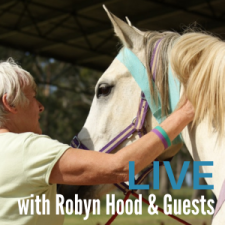
Interactive & Online Tellington TTouch® for Horses
Immersion Series with Robyn Hood & Guests
Join Tellington TTouch Method Instructor, Robyn Hood, as well as other guest instructors, including special sessions with Linda Tellington-Jones, and develop a deep level of understanding and skill that will transform how you understand, handle and train horses.
This course is the ideal option for anyone seeking an integrative and compassionate approach to horse training and management. It will provide you with an incredible framework of philosophical understanding, observational skills, bodywork techniques, groundwork exercises, innovative tools, and work under saddle that can make what you already do well, be even better; all while developing a deeper, more trusting relationship.
Enjoy the logical, linear, learning of online learning along with the inspiring and adaptive format that includes 36 (up to 72 with both classes) hours of small, LIVE, Zoom sessions – all recorded for your convenience and on-going learning.
$999.00
Dates: Saturdays starting September 28, 2024
(Enrollment is open throughout this time period)
Time: 8:00 – 11:00 PT/ 16:00 – 19:00 GMT via Interactive Zoom Sessions
(Recorded in case you miss a session!)
AND/OR (students may choose which session they attend)
Saturdays for Australia: 9:00 – Noon Sydney time/ Fridays: 14:00 – 17:00 PT
Full Details and Registration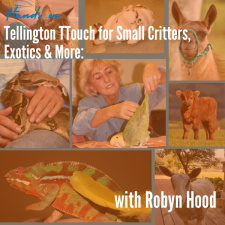
Hands On -Tellington TTouch® for Small Critters, Exotics and More
Introduction to Tellington TTouch for Multispecies Care – Cross Training for Your Skills
Date: April 9, 2025
$167.97 approximately the equivalent to £125 GBP
Discover a Revolutionary Approach to Animal Well-being and Connection
Join us for an immersive one-day workshop exploring the Tellington TTouch Method, a gentle, hands-on technique that transforms the way we interact with animals. Designed for animal enthusiasts, caregivers, and professionals, this session provides a unique opportunity to learn how to improve well-being, behavior, and cooperation while deepening trust and communication between humans and animals.
What You’ll Learn:
- Tellington TTouch Bodywork: Master the foundational hands-on techniques that promote relaxation, reduce stress, and improve function for animals of all ages and species.
- Multispecies Focus: While we’ll focus on dogs, cats, and people, you’ll also learn how to adapt these techniques for a variety of animals, including small farm animals, reptiles, alpacas, parrots, and more.
- Tailored Solutions: Understand how to customize TTouch for each animal’s unique needs, rather than relying on a one-size-fits-all approach.
This workshop is perfect for:
- Pet guardians looking to enhance their relationships with their animals.
- Professionals in animal care, including massage therapists, trainers, and veterinarians.
- Animal lovers eager to cross-train their skills and learn techniques for a wide range of species.
No prior experience is needed, and the techniques are easy to learn and apply. By the end of the day, you’ll have the tools and confidence to make a meaningful difference in the lives of the animals you care for—and in your own life, too!
View Details and RegisterEvents > Past Events Archive
Interactive & Online Tellington TTouch®
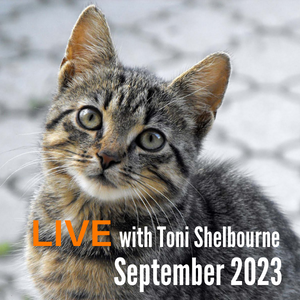 Getting in TTouch with Your Cat with Toni Shelbourne
Getting in TTouch with Your Cat with Toni ShelbourneOn September 10th & 17th (16.00 – 18.00 GMT) join Toni Shelbourne , Tellington TTouch Instructor, author and Animal Behaviourist, takes you through the steps to begin understanding and interacting with your cat in a more positive, mindful, and proactive way.
Learn how to notice subtle changes and communication signals that you cat is trying to convey to you and understand how you can adjust and adapt your approach to each individual animal. This course includes 4 hours of live, interactive, virtual learning AS WELL AS, online course material, available to you 24/7 with lifetime access.
Taking what you observe, discover the versatile and adaptive TTouch body work techniques that allow you to make positive contact with your cat, in a way they enjoy and look forward to; deepening your bond and helping your feline friend become more comfortable and relaxed.
In addition to simple yet effective TTouch techniques, discover fun, interactive exercises that will engage your cat and help transform apprehension or indifference into curiousity and engagement.
Use your new skills in practical applications, learning how to help your cat become more comfortable in typically challenging everyday handling scenarios such as, Vet visits, nail trimming, and more!
This course can count (4 credits) as an Elective towards the Tellington TTouch Practitioner Program.
visit this website for more info
TTouch for You: Inspiring Self Care
Connect With The Magical Intelligence Of Your Body
Tellington TTouch® is a simple, proven method of touch that has been used to improve the lives of thousands of people and animals throughout the world.
Learning TTouch® for Self-Care.Releasing anxiety and pain with TTouch® and gratitude.A supportive community sharing TTouch® in a global online setting.Connecting to the Creative Life Force in every cell in your body.The merging of science and spirituality.
This program offers credits for those looking for TTouch For You practitioner status. To learnmore email kirsten@ttouch.com.
In this online, interactive course, you’ll discover what thousands have already experienced first-hand: the life-changing power of Tellington TTouch®!
$89/month or $979/yr
Dates and Times of Live Training Classes:
Each Class is 3 hours, and all classes are on Sundays at: 10:00 am Pacific Time / 11:00 am MT / 12:00 pm CT / 1:00 pm ET BONUS Weekly ‘Live With Linda’ Tuesdays each week at 11am -1 pm Pacific
Details and RegistrationOur Method for > Horses > Success Stories
Workshop attendees comment!
"This line of work has opened up a new world of alternative training which is sympathetic and supportive to the horse. The results were outstanding and immediate."
– John
"TTOUCH has awakened me to a whole new (wonderful) world. I feel things and look at things (animals, people, etc.) in a renewed and understanding way. I myself feel different too. When in a situation I handle it much differently than before. I have stopped blaming the animal/person and begun to search for the real cause of the problem."
– Sharon Crement
"A novice can do the Tellington TTouch Method It's easy to make changes very quickly even for a novice person that doesn’t do the work as effectively as an experienced person. It’s not necessary to know the work perfectly.
"It's truly amazing to be able to make changes in an animal’s behavior, physical being or mental state, and have a reciprocation take place. For every animal I see being helped by TTouch, I always feel I have learned and changed in the process as well."
- Amanda L.
"The Tellington Method teaches me to be a partner with my horse so I can learn to be a team. It gives me the tools to LISTEN, OBSERVE, COMMUNICATE and then give back information to our animal friends so that they can teach me to become more effective. TTouch brings joy to my horse and me."
– Amy Kendis
"This workshop has totally changed the way I view myself as a partner to my horse, our relationship and the relationship of the people and horses around me."
– Whitney Knauer
"The evening the clinic ended, my daughter was riding her Appaloosa mare (not at the clinic) in a drill team practice. The horse was a bit antsy and would not stand quietly. Rather than disciplining her as I have in the past, I spent a few minutes doing mouth work and some touches along her neck. She settled down immediately and stood quietly."
– Denise Schoenladler
"Thank you for the marvelous lessons, ideas and awareness you’ve brought to my life. My animals, family and I appreciate what I’ve learned from your lessons, patience, carefulness etc. I enjoy meeting new horses and watching, reading and understanding them because of what I’ve learned from 'Getting in TTouch' and being able to help relax, soften and relieve tension from horses whose caretakers haven’t had the chance to study and use your methods."
– Terri Rexroad
Professional trainer impressed!
"This TTouch Training showed me:
effectiveness in changes
new realizations
confidence
philosophy
strength to be “weird”
appreciation and honor to all animals - we are all the same at cell level.
"At the end of this week-long training (my 6th or 7th, I think), I am once again struck by how powerful the TTouch method is. The combination of the TTouch body work, the ground work and leading, and the overall philosophy creates overall changes in the horses and in the people working with them. I have never seen this in any other system in my 25 years of working with animals.
"These competitive event horses began with very obvious problems: stiffness, short-strided, uneven gait, high headedness, dragging the rider to the jumps, kicking, biting, unwillingness, lack of attention. In every case there was dramatic improvement.
"We were fortunate to have top level riders who showed us their horse being led and being ridden nearly every day. This allowed us to see the changes in the horses after being worked each day by the clinic participants. It also allowed us to see the riders soften and ride more correctly after using the specialized TTouch equipment in their riding sessions. It was a joy to observe the riders' pleasant surprise as the horses became easier and more enjoyable to ride.
"After working as an animal professional for almost 20 years, I was so impressed by Tellington TTouch effectiveness. In the years since then, I’ve used it more and more in my work. I continue to learn better ways to work with animals through TTouch trainings and to be constantly amazed by the changes the TTouch method for horses brings about.
- Penny Stone
Our Method for > TTouch-for-You > Why TTouch-for-You
Arthritis in Knee
Combining Tellington TTouch and Feldenkrais for extreme arthritis in knee due to poor posture. Client: female - 48 years old
This patient had her first surgery when she was 18 years old. When bending the knee at a certain angle she sometimes would loose control of her right knee and fall down. Repositioning the ligaments should have helped, but the surgery was not successful.
To avoid falling the patient developed the habit to straighten the knee instead of bending it while walking. Due to many years of this poor way of moving a strong case of arthritis developed in her knee. In March 2006, she once again underwent surgery on her meniscus. This surgery, followed by intense Physiotherapy also did not bring any relief and required weekly drainage. A friend suggested she'd come to me for a Feldenkrais session.
I combined TTouch for You and Feldenkrais as follows:
With specific Feldenkrais exercises we searched for the "right" gait, the physiological movement of the walk. The ankle had "forgotten" that it had to move, there was no possibility of up or down movement. The leg was lifted by a swing of the hip, foot and knee remained stiff.
With the lightest impulses, we organized the body in a way that foot, knee and hip were able to "learn" to move properly. To heal the arthritis in her knee I treated the patient 20 minutes at the beginning and end of each session with TTouch on her right leg with the following TTouches:
Abalone pressure 1, two-second TTouches on the whole leg including knee starting at the hip down to the foot.
Lying Leopard pressure 1, one-second TTouches on the inside of the upper thigh down to the knee and then on the outside of the upper thigh.
Raccoon TTouch, pressure 1, one-second TTouches around the area of the knee and later directly on the knee.
At the end of the session Lying Leopard with pressure 1, one-second TTouches on the entire leg and ending with octopus on both legs.
After three weeks, the ankle has much more movement. The knee is starting to bend and the hip slowly leaned a new movement. we continued working on the movement of knee, foot and hip with Feldenkrais. I also use TTouch on the knee including in positions that are similar to a normal gait, with the patient standing with one leg ahead of the other, putting some pressure on the ligaments and tendons. I used the following TTouches:
Abalone, pressure 1, two-second TTouches on the right leg.
Raccoon TTouch, pressure 1, one-second TTouches around the knee and along the path of the tendons and ligaments going up to a pressure 3.
The fluid build-up in the knee has noticeably been reduced and the patient is using less pain medication.
After six weeks of therapy:
On flat ground and light incline the gait is normal. When the patient gets tired there is a slight unevenness in her rhythm. She puts more weight on the strongest leg and keeps it on the ground for two seconds while to injured leg stays on the ground for one second. Only when she walks downhill is there a chance of the knee collapsing on her. There is no more access fluid in her knee and it no longer needs to be drained. The patient is NOT using ANY pain mediation
The case study is not yet finished, but it showed very clearly how the combination of TTouch for You and Feldenkrais encouraged the healing of an old condition.
Marie-Jeane Dufour, Certified Feldenkrais Practitioner and TTouch for You Practitioner
TTouch & Heart Resonance & The Role of Intention
By Robin Bernhard LCSW, MED
The universality of Linda’s methodology is unique to TTouch. Linda didn’t have to develop different techniques to teach horses, whales, snakes, parrots, cats, dogs or humans. TTouch works for all species. Through touches that are universally understood, Linda and her students of TTouch, invite their animals to participate in harmonious mutual communication; cell to cell and heart to heart. In her book, Tellington TTouch, Linda states: “Instead of seeing the TTouch as something that I do to animals, which would create separation between us, I view the circles as a way to come into cellular harmony with them, a way of allowing my cells to speak to theirs. At a cellular level, no living thing is alien to any other, and so the sense of connections remains the same whether I’m working with a gerbil or a lynx, a kitten or an elephant.” Both the practitioner and the animal benefit from the mutual communication.
Linda believes that the TTouch practitioner’s intention for healing is communicated from the person to the animal (or person to person) on many levels. These intuitive ideas are now being scientifically documented by The Institute of HeartMath with new research about mind-body communication and the heart. Research at The Institute of HeartMath has shown that we can regulate heart rhythm coherence by holding positive feelings and intentions. Increased heart rhythm coherence produces more alpha brainwaves, enhanced awareness and improved cognitive performance. Alpha frequencies induce a state of tranquility, not unlike the tranquility experienced during TTouch, and interestingly, alpha brainwaves are associated with peak performance. The results of the research at the institute of HeartMath supports the hypothesis “that the changes in brain activity that occur during states of increased psychophysiological coherence lead to changes in the brain’s information processing capabilities. Results suggest that by using heart-based interventions to self-generate coherent states, individuals can significantly enhance cognitive performance.” It would be very interesting to see if TTouch enhances heart rhythm coherence. I suspect that it does.
The heart produces an energy field that can be measured for five feet in all directions. It is quite possible that all species are able to perceive influences from another being’s heart from a short distance. When humans communicate and touch is involved, the brain registers the heartbeat of the other in the EEG, physiological evidence that we are influenced by another’s heart rhythm chaos or coherence. Research has shown that horses are sensitive to the heart energy fields produced by humans and that humans are sensitive to the fields produced by the horse’s heart. The practitioner of TTouch knows well the experience of peace that comes while engaged in the practice of TTouch. Scientific knowledge about the energetic communication from the heart suggests that TTouch practitioners are energetically engaging their animal partners at the deep level of the heart. When the TTouch practitioner consciously holds the intention of healing and a compassionate attitude to generate heart rate coherence within the self, the person or animal being touched benefits from the calming influence of the energy field created by the practitioner’s heart. The research at the Institute of Heart Math suggests that the heart to heart engagement is reciprocal and thus, we have the beginnings of scientific documentation for the experience of healing intention, compassion, respect and positive regard that is part of TTouch practice.
There are more neurons running from the heart to the brain than from the brain to the heart. Some research suggests that the heart directs brain regulation and not the other way around. Linda has stressed the importance of holding a compassionate attitude coupled with the desire to support healing as the correct mind-set for the TTouch practitioner to allow the heart to influence the work. The research on the power of the heart from The Institute of HeartMath documents the scientific basis for what Linda understood intuitively about the heart’s influence on TTouch outcome and the mutual benefit for the practitioner and the animal when the practitioner intentionally generates a genuinely positive heart felt connection between the self and the animal during a TTouch session.
On the other hand, forceful methods generate fear and impede “thinking” as the horse moves into its instinctual fight/flight survival mode. During fight/flight activation, thinking is shut-down in favor of split-second non-thinking reflexive reactions that the horse can’t control. It is often in this fear driven state that horses can’t meet the demands placed upon them, for which they are frequently punished and pushed further into fear, pain and freeze responses. Instinctual reactions may be activated through a dominating relationship, and animals can be managed through such training methods. TTouch does not elicit instinct driven behavior mediated by the limbic system, rather Linda seeks to calm the limbic system and stimulate learning that is mediated by the cortex through a relationship infused with a heart-felt connection.
Shop > Dogs > Books
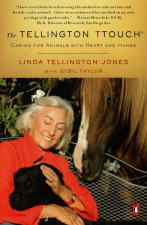
The Tellington TTouch®: Caring for Animals With Heart And Hands
2008 edition with a new cover and some edits.
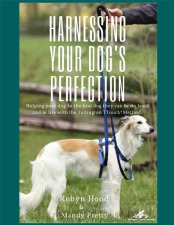
Harnessing Your Dog's Perfection
Discover simple, non-threatening Tellington TTouch exercises and techniques that promote relaxed, enjoyable, loose leash walks for dogs and their people.
Shop > Horses > Books
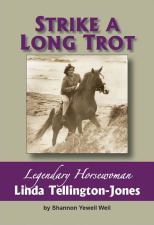
Strike A Long Trot: Legendary Horsewoman Linda Tellington-Jones
This book chronicles the distinguished early equestrian career of Linda Tellington-Jones.
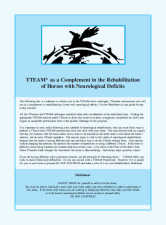
Rehabilitation of Horses - Booklet
Useful techniques to help your horse recover from neurological deficits including EPM.
Shop > Horses > Equipment
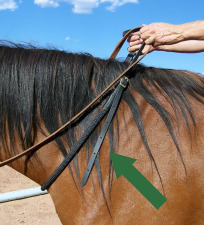
Balance Rein - Woven
Good for horses who are above the bit, behind the vertical or strung-out. New lower price!
Worldwide > Animal Ambassadors International
1990 TTEAM and Special Education
TTEAM News International October, 1989 Vol 9 No 3 Pp. 21-23
Bonnie Lieuwen of College Station, Texas attended a workshop with TTEAM Instructor, Copper Love who encouraged her to write about how she had been using TTEAM in her special education classroom.
FOCUS: As a special education teacher I am most concerned with my students increasing their focusing skills. As we all know, if a person can focus & concentrate their focusing skills then they can expand academically, emotionally, socially, and physically. Sort of like a snowball effect, expanding in their skills, independence, and self-esteem. In my thirteen years of experience, this was the first year that I taught at the elementary age level (ages six - ten). Due to the students' handicaps, young ages, and extreme amount of energy, focusing was not one of their strong qualities. I tried many different techniques to increase their focusing skills with very little growth for the effort that was expended. It was not until I began using some TTEAM techniques that I started to see notable growth.
Other areas that I saw results from using TTEAM with the students were: body-awareness/use/carriage, relaxation, and decrease in hyperactive behavior. Increase in socialization, increase in behavioral self-control, increased awareness of self, others, and the environment, increase of following directions skills, decrease in aggressive behaviors, increase of willingness and enjoyment of being touched and touching others, the skill of waiting, increased feelings of acceptance, increased feelings of bonding and trust between student and teacher, and more I'm sure.
In special education there are so many variables and different specialists that work with these children (speech, adaptive p.e., physical/occupational therapists, counselors) and everyone has good input into the growth of these children. It is always difficult to pinpoint the most effective techniques and many times it is a combinations of everyone's input. But I do know that when I began using TTEAM, I began seeing exciting changes and other people (plus parents) were reporting these changes too. I will not be working with these students next year so I will have no idea of the lasting effects in their growth. Please remember these are only my observations and feelings. It is my gut feeling that TTEAM had a crucial positive effect on these children.
In the following paragraphs I will briefly tell you about the TTEAM activities and adaptations I used and the five students that received the most TTEAM energy. The time span was about two months, but not on a daily basis. In fact I found myself becoming very frustrated that I did not have the time I wanted to spend doing TTEAM. I saw the benefits and ached with the thought "if I only had more time to spend individually with each student."
In a school setting I thought it might look odd to use my horse wand so I substituted the wand with a drum major's baton. I found it worked well because it has the two white rubber ends and I could remind the kids to look (focus) at the white tips (we called then marshmallows). There are many stick things that would work well (is conductor baton, a painted stick, etc.) I just happened to have the baton.
With the baton we did:
- open the gate
- walk, turns, backward walk, run
- wave to stop
- dagger; this was especially for "J" who I will tell you about later.
Obstacles: I used sticks that were about 6 ft. by 1 inch (they were light weight and easy to arrange).
- Labyrinth (varying the pattern)
- cavaletti (arranged at different heights/distances)
- star
- the "pick up sticks arrangement
Other obstacles:
- a tic-tac-toe design. I would use the baton to point to a square for the student to step into, this one worked very well for teaching them to focus on where the baton point, for increasing the awareness of space and feet placement, and for waiting in one place.
- Box Lids. (I'm sure you have seen when stores cut in half, all the way around, a case of canned soda and each box part is about 2 inches high, well that is what I used). I would arrange the boxes on the floor in varying patterns and again I used the wand to point to the box I wanted the student to step into.
The boxes and tic-tac-toe were terrific for a group because I could direct one student and while the one student learned to wait in one space I could direct another, and so on. This really helped my students that were very compulsive in their movements, They had to think in order to control their bodies. It was a great exercise!
Other things:
Labyrinth - when the students became skilled in these (in the beginning they would plow right through the sticks, absolutely no awareness of the sticks or that they were plowing through) I made the addition of two labyrinth patterns. We used chairs with wheels and without. It was really neat to see the students expand from plowing through, to thinking their own bodies through, to having enough control to push a chair through the pattern.
Flashlight - After they had learned to focus on the baton I would sometimes use a flashlight beam instead of a baton. I would turn down the lights and shine the flashlight to direct them in the obstacle patterns. This is interesting: I had used a flashlight all year hoping to increase their focusing skills, but it was not until they had learned to focus on the baton that they finally were able to truly focus on the flashlight beam.
I did not get a chance to use the following ideas but I thought they might be good.
- Rope: Take a long rope or several ropes to make varying obstacle designs.
- Tires: Substitute the large tires (used with the horses) with bicycle tires or tubes, hoola -hoops, or some other light weight circular shapes.
- Rag squares pattern.
- Pulling a wagon
- Varying the body movements through the labyrinth: while crawling, hopping and running.
And of course I used the wonderful "CIRCLES"!
Students: J., N. , K. , M. , C.
J. (10 yrs, he has a mental retardation handicap, very hyperactive) - when J. came to
my class in late October he walked with his shoulders hunched over, head down towards the ground, and his hands hold in a wrapped position on top of his head. His body language told that he was hiding within a shell. He did not talk, he only made a very occasional vocal sound (but he had Used words occasionally throughout his life). He was shy and withdrawn socially, would not focus on anything or anyone. He would not follow directions and when he was corrected on behavior he would fall to the floor with tantruming, crying and screaming. He frequently hit peers or tried to play too aggressively. He would often, just out of the blue, take off running away from staff. He was very hyperactive and easily over excitable.
I tried many techniques to improve his posture, nothing had much effect. In the month of February I tried doing circles on his shoulders, neck, and back. These areas were extremely tight, by my feel and by his own reaction. It was interesting that while doing the circles he would lower his arms but they would return minutes after I stopped doing the circles. Daily I did circles on his shoulders, back, and neck and daily the length increased that he would leave his arms down. At the end of March, after I had attended a TTEAM clinic, I began increasing circle time/ body areas and incorporating TTEAM activities. With the increase of TTEAM I began to do, J. really improved in all areas. His major growths were truly observable by the end of May. He walked upright, hands down with only an occasional verbal reminder, he learned to walk and stop which greatly helped staff because it decreased the number of times they would have to run after him. He made great leaps in his ability to focus and attend to tasks, and he began using words to state his needs i.e. water, bathroom, ball, play, others' names, bus, etc. Socially he became more aware of those around him and he was interacting non-aggressively. At lunch time all my students had a regular education student for a lunch buddy. Each of my students would sit with their lunch buddy at the lunch buddy's class table. Daily I watched J's interactions with the lunch class/ buddy become more calm and appropriate. He became more calm/relaxed and he definitely increased his ability to follow directions and to accept correction calmly. I feel sure the TTEAM obstacle activities had a great effect on his self-control, focusing, increased awareness of' his environment, and the decrease in his compulsiveness. J. loved the circles so much that he would take my hand and show me where he wanted circles, he also would try to do circles on others. It was a total joy to watch the growth he was making.
N. (6 yrs. mental handicap, slight degree of' cerebral palsy). M. had extreme baby behaviors: he refused to follow directions by excessive tantruming, hitting, spitting, crying, and throwing himself on the floor. He was extremely dependent on others to do things for him. Very low focusing abilities and very short attention span. When N. first came to my class in October I thought if this child learns to remain in his seat for five minutes it will be a miracle. Well N. passed that goal up by far. He made wonderful progress with a lot of physical guidance and verbal direction. He had already come a long way when I began doing TTEAM with him in the end of March. And once again I don't think it was coincidence that this student began to make progress more rapidly when I began the TTEAM. N. resisted the circles at first so I had to stick to the 'flick of the bear's paw" for the first week. After that he was very receptive to the circles and by the end of May he would ask for circles. I feel that N. made a lot of emotional progress in body awareness and use. It's as if he had discovered his body and its movements. N. also grew in independence and in following directions. I could see him improve and feel good about the TTEAM obstacles and learning these simple task directions seemed to carry over into following directions in other areas.
K. (7 years. Learning Handicap, hyperactive). K. was my speed student. He sped through everything just to get it done. His focusing ability was very poor. K. was in my room only in the morning so the only TTEAM I did with him was the Circles and the baton, open gate, walk, stop. I feel this greatly improved his ability to slow down and to focus. I would also let K. run in a circle around me plus focus on the baton and verbal directions. This seemed to be effective in releasing his excess energy, increasing his focusing, and increasing his following direction skills. K. seemed to react to the circles very emotionally. Some days he was very resistive to the touch. He was a child that did not feel comfortable with touch. Several times after I began circles on him he would have crying episodes (not within the circle session, but at later times). I took the circles very slowly with K. in case they were causing the crying. In time he became more receptive to the circles and the crying episodes ceased.
M. (10 yrs., Mental retardation handicap, very cerebral palsy, Used a walker to walk). M. came to my class the last month of school so he did not participate in a lot of' TTEAM. I observed some progress that I feel was a result of TTEAM. M. was not happy in our class when he first came. He had recently moved from another town where he was very happy in his class. I feel the circles helped him feel more trusting and bonded in our class at a more rapid speed than he would have without the circles.
C.* (9 yrs., regular education. student that was placed in my classroom due to severe emotional and aggressive outbursts within his regular classroom. C. is very intelligent, creative, and sensitive.) A teacher's aide worked with him in a partitioned off area of my classroom. I worked with him for 30 minutes a day. We worked on social/personal skills, breathing, guided imagery, and of course CIRCLES! C. loved the circles, especially on his face. He told me the circles made him feel relaxed and peaceful. We used the circles many times when he was feeling upset. Every time he would feel better and refrain from inappropriate or aggressive behavior.
I hope that I have at least been able to cover the highlights of what I feel TTEAM did for my students. I'm not sure who benefited the most from TTEAM - my students or me. I do know that now I have seen the benefits with my horses, with my students, with myself and I thank you for sharing TTEAM with the earth.
NOTE: TTEAM is an acronym of "Tellington TTouch Equine Awareness Method." Since this article was written, Linda decided to use a brand name for all the facets of the TTouch organization. Currently, that is Tellington TTouch® Training.
2004 Visit to the Oakland Zoo Goat Rangers and Giraffes
In October, 2004 I joined Practitioner Jaynellen Kovacevich and her Oakland Zoo "Goat Rangers" for a presentation to the youth and their parents. Jaynellen's program won the Oakland Zoo "Volunteer of the Year" award for 2003.
Jaynellen arranged this presentation and potluck lunch with me as a reward for the Goat Rangers.
Their parents were invited to spend the day at the zoo with their rangers, the youngest volunteers at the zoo, to learnmore about the program and the benefits of TTouch. This was also an opportunity for the parents to hear about the special contribution the Goat Rangers have made to the zoo and to show pride in them for their accomplishments.
It was especially wonderful to have this chance to honor the work of Jaynellen. She is both a Companion Animal and a TTEAM Practitioner in addition to being a special education teacher. Jaynellen has been teaching TTouch in her school classes for almost 20 years, since the beginning of the Animal Ambassador program.
I talked about the history of Animal Ambassadors International® and how I was inspired with the idea of Animal Ambassadors International from my work in Russia with children and animals beginning in 1985. That was the year that I organized a telephone exchange between a school in Moscow and a school in Utah. In both schools the kids could hear each other (through the interpreters) over loudspeakers that could be heard ri all the classrooms. How rewarding it is to see this concept of animals being our ambassadors for promoting understanding between people and animals these 19 years later.
I presented the Goat Rangers with Animal Ambassador certificates that state, "I hereby vow to use my hands, my heart and my voice to speak for and protect all . . . . . (This space is then filled in with the name of the animal or animals the recipient chose. Many of the youth wrote in "all animals.”)
After lunch we spent an hour with the goats and sheep in the petting zoo, where the rangers introduced me to their favorites, including Pygmy goats, an Alpine, a Nubian, a La Mancha goat and a flock of Barbados sheep. It was exciting and impressive to watch the Goat Rangers as they TTouched several of the senior goats who are being treated by the zoo veterinary staff and zookeepers for arthritis. Educational staff members and keepers have noted that the Goat Ranger program and TTouch have been beneficial to these older goats as well as the other goats and sheep.
Jaynellen has been teaching this class twice a month for almost four years at the Oakland Zoo and has shared the benefits of TTouch with many educational staff members, zookeepers and docents. When she began the program, many of the sheep and goats shied away from being touched. They were used to the public feeding them, but often they were approached by young children pulling on their horns, face or legs. In return, the goats often tried to escape by butting the children. Sometimes parents pushed or hit the goats and sheep to keep them away when they were aggressive about getting food. Not exactly ideal for a petting zoo.
Jaynellen taught her Rangers how to teach visiting children to quietly and respectfully groom the goats and sheep with a soft brush and to do some TTouches on them. Every two weeks for the past four years the Goat Rangers have been handling the goats and sheep in this way.
I just could not get over how gentle and relaxed the animals are. Normally one has to be careful around goats with horns because they can make abrupt moves with their heads and hurt you unintentionally. These goats are so quiet and careful with their heads and will lie still for ages to be groomed gently and TTouched. This gives visiting children and their parents a new way to be around animals with gentleness and respect.
Jaynellen and Avril Keimey, one of the first Goat Rangers, commented that the behavior of the goats and sheep changed dramatically with the use of TTouch and brushing. Avril had this to say about the program: "I used to go to the Zoo when I was younger, and I was one of those kids who was afraid to go into the petting zoo because there were goats jumping on people. About four years ago, I became a Goat Ranger, and started doing TTouch on the goats and sheep, and showing little kids how to pet them nicely. In the time I've been a Goat Ranger, I have seen a huge improvement in the animals' behavior. They approach people instead of running away. I now see very few kids who are afraid to go up to the goats."
Later in the day, Roland and I were shown video footage of the Goat Rangers teaching visiting kids of all ages, including parents, how to gently brush and TTouch the goats and sheep. It is fascinating and inspiring to watch kids enter the area with rambunctious behavior, and within five minutes be relating quietly to the animals. It's totally intriguing to listen to these young Goat Rangers demonstrate and explain exactly how to gently brush the goats. On the video you see goats lying perfectly still, often with eyes half closed, or sometimes lying flat on their sides, enjoying every minute of the interaction. These Rangers are awesome Animal Ambassadors and articulate, patient teachers.
Gail Ellis, School Programs Manager, The Oakland Zoo, said: "There has been an obvious and dramatic change in the behavior and temperament of both the animals and the youth involved. It has been amazing to see."
The "Goat Rangers" are volunteer kids between the ages of 12 to 17. The youth have to commit to six months of volunteer work to be accepted in the program and Jaynellen puts them through a rigorous interviewing process before they are accepted.
NOTE: TTEAM is an acronym of "Tellington TTouch Equine Awareness Method." Since this article was written, Linda decided to use a brand name for all the facets of the TTouch organization. Currently, that is Tellington TTouch® Training.




